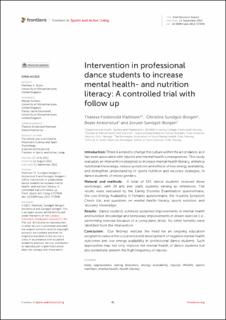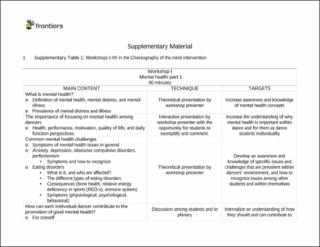| dc.contributor.author | Mathisen, Therese Fostervold | |
| dc.contributor.author | Sundgot-Borgen, Christine | |
| dc.contributor.author | Anstensrud, Beate | |
| dc.contributor.author | Sundgot-Borgen, Jorunn | |
| dc.date.accessioned | 2022-12-01T12:05:42Z | |
| dc.date.available | 2022-12-01T12:05:42Z | |
| dc.date.created | 2022-10-26T12:55:22Z | |
| dc.date.issued | 2022 | |
| dc.identifier.citation | Frontiers in Sports and Active Living. 2022, 4, Artikkel 727048. | en_US |
| dc.identifier.issn | 2624-9367 | |
| dc.identifier.uri | https://hdl.handle.net/11250/3035326 | |
| dc.description | This is an open-access article distributed under the terms of the Creative Commons Attribution License (CC BY). The use, distribution or reproduction in other forums is permitted, provided the original author(s) and the copyright owner(s) are credited and that the original publication in this journal is cited, in accordance with accepted academic practice. No use, distribution or reproduction is permitted which does not comply with these terms. | en_US |
| dc.description.abstract | Introduction: There is a need to change the culture within the art of dance, as it has been associated with injuries and mental health consequences. This study evaluates an intervention designed to increase mental health literacy, enhance nutritional knowledge, reduce symptoms and effects of low energy availability, and strengthen understanding of sports nutrition and recovery strategies, in dance students of mixed genders.
Material and methods: A total of 125 dance students received three workshops, with 39 arts and crafts students serving as references. The results were evaluated by the Eating Disorder Examination questionnaire, the Low Energy Availability in Females questionnaire, the Hopkins Symptom Check List, and questions on mental health literacy, sports nutrition, and recovery knowledge.
Results: Dance students achieved sustained improvements in mental health and nutrition knowledge and temporary improvements in driven exercise (i.e., performing exercise because of a compulsive drive). No other benefits were identified from the intervention.
Conclusion: Our findings indicate the need for an ongoing education program to reduce the occurrence and development of negative mental health outcomes and low energy availability in professional dance students. Such approaches may not only improve the mental health of dance students but also potentially prevent the high frequency of injuries. | en_US |
| dc.language.iso | eng | en_US |
| dc.subject | body appreciation | en_US |
| dc.subject | eating disorders | en_US |
| dc.subject | energy availability | en_US |
| dc.subject | health literacy | en_US |
| dc.subject | injuries | en_US |
| dc.subject | mental health | en_US |
| dc.subject | sports nutrition | en_US |
| dc.title | Intervention in professional dance students to increase mental health- and nutrition literacy: A controlled trial with follow up | en_US |
| dc.type | Peer reviewed | en_US |
| dc.type | Journal article | en_US |
| dc.description.version | publishedVersion | en_US |
| dc.rights.holder | © 2022 Mathisen, Sundgot-Borgen, Anstensrud and Sundgot-Borgen | en_US |
| dc.source.pagenumber | 14 | en_US |
| dc.source.volume | 4 | en_US |
| dc.source.journal | Frontiers in Sports and Active Living | en_US |
| dc.identifier.doi | 10.3389/fspor.2022.727048 | |
| dc.identifier.cristin | 2065241 | |
| dc.description.localcode | Institutt for idrettsmedisinske fag / Department of Sports Medicine | en_US |
| dc.source.articlenumber | 727048 | en_US |
| cristin.ispublished | true | |
| cristin.fulltext | original | |
| cristin.qualitycode | 1 | |

